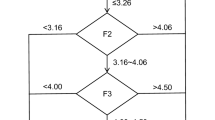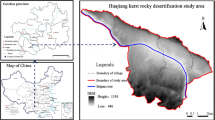Abstract
Rocky desertification of karst in Southwest China has seriously influenced the normal life of local people. Soil erosion is the key process for inducing rocky desertification. This paper analyzes the stability and variation of shear strength under different of water contents of the brownish clay soil in carbonate rock area Chenqi of Puding in Guizhou province. Results show that the cracking of brownish clay soil aggregates occurs in the early soaked stage. The lower the initial water content of soil aggregates, the faster and more completely large particles disintegrate. Stability of soil aggregates is stronger with higher water content, but the entire shear strength decreases significantly; it will collapse entirely in the rainy season. Therefore, for desertification prevention and control in carbonate rock areas, greater attention should be given to effective protection measures during the rainy periods after long-term dry weather. The control during this period is essential in the whole process of desertification mitigation.








Similar content being viewed by others
References
Chen ZY, Zhou JX, Wang HJ (1994) Soil mechanics. Tsinghua Publishing House, Beijing
Duiker SW, Flanagan DC, Lal R (2001) Erodibility and infiltration characteristics of five major soils of southwest Spain, Catena, vol 45, issue 2, pp 103–121
Ellison WD (1947) Soil erosion studies. Agric Eng 28(4):15–146
Koutepov VM, Mironov OK, Tolmachev VV (2008) Assessment of suffosion-related hazards in karst areas using GIS technology. Environ Geol 54(5):957–962
Le Bissonais Y (1996) Aggregate stability and assessment of soil crustability and erodibility—(I) theory and methodology. Eur J Soil Sci 47(4):425–437
Li DW, Cui ZJ, Liu GN, Feng JL, Cao J (2001) Formation and evolution of karst weathering crust on limestone and its cyclic significance. Carsologica Sinicav 20(3):183–188 (in Chinese, English summary)
Liu LW, He ZY, Wang Q, Li SH (2004) Economic profits analysis of soil and water conservation project based on GIS—take Wangjiagou watershed as an example. Eng J Wuhan Univ (6):40–43
Nearing MA, Lane LJ, Alberts EE, Laflen JM (1990) Prediction technology for soil erosion by water—status and research needs. Soil Sci Soc Am J 54(6):1702–1711
Olson TC, Wischmeier WH (1963) Soil-erodibility evaluations for soils on the runoff and erosion stations. Soil Sci Soc Am J 27(5):590–592
Ramos MC, Nacci PI, Pla I (2003) Effect of raindrop impact and its relationship with aggregate stability to different aggregation forces. CATENA 53(4):365–376
Serrano SE (2001) Explicit solution to Green and Ampt infiltration equation. J Hydrol Eng 6(4):336–340
Walker JD, Walter MT, Parlange J-Y, Rose CW, Tromp-van Meerveld HJ, Gao B, Cohen AM (2007) Reduced rain-drop-impact driven soil erosion by infiltration. J Hydrol (Amsterdam) 342(3–4):331–335
Wang SJ (2003) The most serious eco-geological environmental problem in Southwest China—Karst rocky desertification. Bull Miner Petrol Geochem 22(2):120–126
Yong NY, Wenzel HG Jr (1971) Mechanics of sheet flow under simulated rainfall. J Hydraul Div ASCE 97(9):1367–1386
Yu JB, Yang LZ, Zhang HS, Fang MZ (1990) Typical karst development in China-assessment and exploitation of Karst water resource in South area of PuDing. Science Press, Guizhou, pp 1–3
Zhang XB, Wang SJ, He XB, Wang YC, He YB (2007) Soil creeping in weathering crusts of carbonate rocks and underground soil losses on karst slopes. Earth Environ 35(3):202–206
Acknowledgments
This investigation is supported by the Chinese National Basic Research Program (an offshoot of the project of Rocky desertification and adaptive ecosystem regulation in Karst mountain region, Southwest China, Process of soil erosion and evaluation of hazard degree of soil and water loss in Karst mountain region, Southwest China), Kwang-Hua Fund for College of Civil Engineering, Tongji University, Project No. 2006CB403203, Shanghai Leading Academic Discipline Project, Project No. B308.
Author information
Authors and Affiliations
Corresponding author
Rights and permissions
About this article
Cite this article
Zhou, J., Tang, Yq., Zhang, Xh. et al. The influence of water content on soil erosion in the desertification area of Guizhou, China. Carbonates Evaporites 27, 185–192 (2012). https://doi.org/10.1007/s13146-012-0104-7
Accepted:
Published:
Issue Date:
DOI: https://doi.org/10.1007/s13146-012-0104-7




